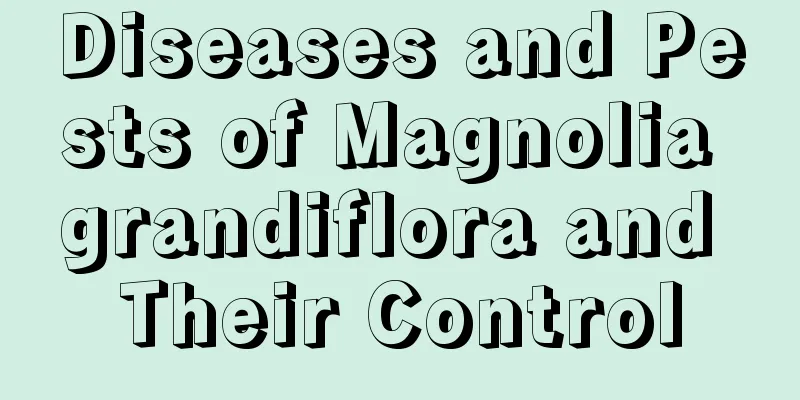Diseases and Pests of Magnolia grandiflora and Their Control

Magnolia grandiflora AnthracnoseThe dangers of anthraxAnthracnose can harm the leaves of Magnolia grandiflora, starting with the adult or old leaves, with the disease beginning at the leaf tips and leaf edges. In the early stage of anthracnose, irregular spots will appear, which will gradually expand and even spread to a quarter of the entire leaf. Disease patternAnthracnose is more serious in rainy and humid weather. Prevention and treatment methodsIn the early stage of anthracnose, you can spray Bordeaux mixture with a 1:1:100 times dilution for prevention and control. Magnolia grandiflora leaf spotThe harm of leaf spotMagnolia grandiflora develops leaf spot disease. In the early stages, the spots are brown circular spots that continue to expand, with the entire spot appearing grayish white inside and reddish brown on the outside. In the later stages of leaf spot disease, the spots will dry up and develop black, granular matter. Disease patternUnder rain and high temperature and dry conditions, Magnolia grandiflora is prone to leaf spot disease. Prevention and treatment methodsTo prevent and control leaf spot disease, first, remove diseased remains in time and burn diseased leaves and dead branches regularly; second, spray fungicides such as carbendazim and methyl thiophanate regularly for sterilization and disinfection. Magnolia grandifloraOccurrence pattern of scale insectThere are generally two generations of scale insects a year, with July and September being its peak seasons. The scale insects mostly parasitize on bud axils, young shoots, leaves and branches, causing great harm. Prevention and treatment measuresEarly to mid-April and mid-to-late August are the suitable periods for the prevention and control of scale insects. The effect of prevention and control at this time is more obvious. The pesticides for prevention and control include Huabao, Antamuprid, etc. Formosan termiteDisease patterns of Formosan termitesThe period from May to late June to August is the peak period for the occurrence of Formosan white termites in Magnolia grandiflora. Prevention and treatment methodsTo prevent and control Formosan white termites, one is to place attractants such as "Yit Ke" in ant tunnels; the second is to avoid mechanical damage to trees; the third is to strengthen maintenance and management, and fill holes in trees in time. Magnolia grandiflora dry rotThe harm of dry rotDry rot mostly occurs on 1-2 year old branches of Magnolia grandiflora. In the early stage of the disease, the bark will become soft and fall off. As the disease progresses, the epidermis of the Magnolia grandiflora will gradually dry up, the subcutaneous part will turn dark brown, and small black spots will grow. Prevention and treatment methodsWhen growing Magnolia grandiflora, you should pay attention to protecting the wounds when pruning the branches, and you can apply protective agents. After the dry rot occurs, apply 800 times diluted 70% thiophanate for prevention and control. Alternaria cinerea leaf spotDamage caused by Alternaria leaf spotThe harm caused by Alternaria gray spot disease is still very serious. In the later stage of the disease, the edges of the spots appear black, the center is white to grayish white, and the black mold clusters will gradually expand. Prevention and treatment methodsFor this disease, first, the diseased remains must be removed promptly, and buried or burned; second, in the early stages of the disease, 600 times diluted 75% thiophanate-methyl wettable powder can be sprayed for prevention and control, spraying once every 10 days or so, and generally 3 to 4 sprayings are required. Magnolia grandiflora spotThe harm of spot diseaseSpot disease is a common disease of Magnolia grandiflora. When the disease occurs, small round spots will grow on the leaves, which are yellow or light brown. The spots will gradually expand, and small black dots will grow in the later stage. When the damage is severe, it can cause leaves to fall off. Prevention and treatment methodsWhen spot disease occurs, the first thing to do is to cut off the diseased leaves in time, and collect the diseased fallen leaves and bury them deeply or burn them to reduce the initial infection source; the second thing to do is to spray 500 times diluted 20% Longke fungus suspension for prevention and control in the early stage of the disease. |
<<: Diseases and Pests of Seabuckthorn and Their Control
>>: Common diseases and pests of African violets and their control
Recommend
Does the Jade Plant shed its leaves in winter? What should I do if the leaves fall off in winter?
1. Do leaves fall in winter? Jade plant is an eve...
How to plant lotus
Preparation for planting lotus Planting time Many...
If there is no stuff in the pot, the flowers and plants will die!
Clay effect: The gaps between ceramsite particles...
The flower language and legend of marigold
The Flower Language of Calendula The flower langu...
How to Make Red Gentian Bloom for Christmas
Real flowering period This red gentian normally b...
Is Dendrobium officinale poisonous? Can Dendrobium officinale be soaked in water and drunk?
1. Is it poisonous? Dendrobium officinale is non-...
What to do if the camellia buds don’t bloom
1. Increase the temperature Reason: Camellia buds...
Is Clematis poisonous?
1. Is it poisonous? Clematis is not poisonous. It...
When is the best month to divide azalea into pots?
1. Time for dividing the pots Generally speaking,...
How to prepare soil for Jade Dew and what kind of soil is suitable
Suitable soil requirements for Jade Dew Jade is a...
How to grow golden-edged spider plants better and more vigorously? Maintenance methods of potted golden-edged spider plants
Chlorophytum comosum is an ornamental plant raise...
When is the best time to plant Guangdong choy sum?
Chinese cabbage, also known as cauliflower and ca...
How to grow Photinia
1. Maintenance methods 1. Potting soil: The photi...
What flowers are suitable for growing in Zhangjiajie? What are the city flowers and trees?
1. Climate characteristics of Zhangjiajie Zhangji...
Are cherry tomatoes a fruit or a vegetable?
Are cherry tomatoes fruits or vegetables? Small t...









